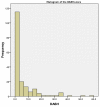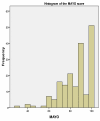Mid-term functional outcome after the internal fixation of distal radius fractures
- PMID: 22280557
- PMCID: PMC3398340
- DOI: 10.1186/1749-799X-7-4
Mid-term functional outcome after the internal fixation of distal radius fractures
Abstract
Background: Distal radius fracture is a common injury with a variety of operative and non-operative management options. There remains debate as to the optimal treatment for a given patient and fracture. Despite the popularity of volar locking plate fixation, there are few large cohort or long term follow up studies to justify this modality. Our aim was to report the functional outcome of a large number of patients at a significant follow up time after fixation of their distal radius with a volar locking plate.
Methods: 180 patients with 183 fractures and a mean age of 62.4 years were followed up retrospectively at a mean of 30 months (Standard deviation=10.4). Functional assessment was performed using the Disabilities of the Arm, Shoulder and Hand (DASH) and modified MAYO wrist scores. Statistical analysis was performed to identify possible variables affecting outcome and radiographs were assessed to determine time to fracture union.
Results: The median DASH score was 2.3 and median MAYO score was 90 for the whole group. Overall, 133 patients (74%) had a good or excellent DASH and MAYO score. Statistical analysis showed that no specific variable including gender, age, fracture type, post-operative immobilisation or surgeon grade significantly affected outcome. Complications occurred in 27 patients (15%) and in 11 patients were major (6%).
Conclusion: This single centre large population series demonstrates good to excellent results in the majority of patients after volar locking plate fixation of the distal radius, with complication rates comparable to other non-operative and operative treatment modalities. On this basis we recommend this mode of fixation for distal radius fractures requiting operative intervention.
Figures
Similar articles
-
[Plate Osteosynthesis of Distal Ulna Fractures with Associated Distal Radius Fractures Treated by Open Reduction and Internal Fixation. Short-Term Functional and Radiographic Results].Acta Chir Orthop Traumatol Cech. 2015;82(5):369-76. Acta Chir Orthop Traumatol Cech. 2015. PMID: 26516956 Czech.
-
Effect of calcium phosphate bone cement augmentation on volar plate fixation of unstable distal radial fractures in the elderly.J Bone Joint Surg Am. 2011 Apr 6;93(7):609-14. doi: 10.2106/JBJS.J.00613. J Bone Joint Surg Am. 2011. PMID: 21471414 Clinical Trial.
-
Clinical impact of United versus nonunited fractures of the proximal half of the ulnar styloid following volar plate fixation of the distal radius.J Hand Surg Am. 2010 Feb;35(2):223-7. doi: 10.1016/j.jhsa.2009.10.035. Epub 2010 Jan 15. J Hand Surg Am. 2010. PMID: 20079580
-
Are Volar Locking Plates Superior to Percutaneous K-wires for Distal Radius Fractures? A Meta-analysis.Clin Orthop Relat Res. 2015 Sep;473(9):3017-27. doi: 10.1007/s11999-015-4347-1. Epub 2015 May 16. Clin Orthop Relat Res. 2015. PMID: 25981715 Free PMC article. Review.
-
Is it really necessary to restore radial anatomic parameters after distal radius fractures?Injury. 2014 Dec;45 Suppl 6:S21-6. doi: 10.1016/j.injury.2014.10.018. Epub 2014 Oct 27. Injury. 2014. PMID: 25457314 Review.
Cited by
-
Functional Outcome of Intraarticular Fracture of Distal Radius Managed by Volar Locking Plate.Cureus. 2020 Oct 31;12(10):e11271. doi: 10.7759/cureus.11271. Cureus. 2020. PMID: 33274146 Free PMC article.
-
Does capsule repair improve the clinical and radiological outcomes of the acute Rockwood type V acromioclavicular dislocations treated with the double endobutton technique?Eur J Trauma Emerg Surg. 2025 Feb 13;51(1):104. doi: 10.1007/s00068-025-02786-x. Eur J Trauma Emerg Surg. 2025. PMID: 39945858
-
Intramedullary nail versus volar locking plate fixation for the treatment of extra-articular or simple intra-articular distal radius fractures: systematic review and meta-analysis.Int Orthop. 2017 Oct;41(10):2161-2169. doi: 10.1007/s00264-017-3460-z. Epub 2017 Apr 7. Int Orthop. 2017. PMID: 28389838
-
Scaphoid Nonunion Is a Disabling Problem in a Military Population.Hand (N Y). 2023 Jan;18(1):122-125. doi: 10.1177/15589447211003177. Epub 2021 Apr 8. Hand (N Y). 2023. PMID: 33829892 Free PMC article.
-
Meta-analysis for dorsally displaced distal radius fracture fixation: volar locking plate versus percutaneous Kirschner wires.J Orthop Surg Res. 2015 Jul 15;10:108. doi: 10.1186/s13018-015-0252-2. J Orthop Surg Res. 2015. PMID: 26169601 Free PMC article.
References
-
- Jupiter JB. Fractures of the distal end of the radius. J Bone Joint Surg Am. 1991;73:461–9. - PubMed
-
- Lichtman DM, Bindra RR, Boyer MI, Putnam MD, Ring D. Distal radius work group. The treatment of distal radius fractures. J Am Acad Orthop Surg. 2010;18:180–189. - PubMed
-
- Handoll HH, Huntley JS, Madhok R. External fixation versus conservative treatment for distal radial fractures in adults. Cochrane Database Syst Rev. 2007;18(3):CD006194. - PubMed
-
- Knirk JL, Jupiter JB. Intra-articular fractures of the distal end of the radius in young adults. J Bone Joint Surg Am. 1986;68:647–59. - PubMed
Publication types
MeSH terms
LinkOut - more resources
Full Text Sources
Medical



